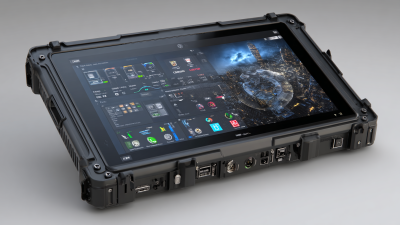5 Essential Tips for Choosing the Right Rugged Industrial Computer
In today's rapidly evolving industrial landscape, the need for reliable and durable computing solutions has never been more pressing. A robust rugged industrial computer is essential for various sectors, including manufacturing, logistics, and field operations, especially where environmental conditions can be extreme. According to a recent report by MarketsandMarkets, the rugged computer market is projected to reach $7.6 billion by 2025, growing at a CAGR of 5.6% during the forecast period. This surge highlights the increasing demand for resilient technology that can withstand harsh conditions, such as temperature fluctuations, humidity, and vibrations. Choosing the right rugged industrial computer not only ensures operational efficiency but also enhances productivity, safety, and data integrity in mission-critical applications. As organizations seek to optimize their industrial processes, understanding the key factors in selecting robust computing solutions becomes essential for staying competitive in today's market.

Key Features to Consider When Selecting a Rugged Industrial Computer
When selecting a rugged industrial computer, it's essential to consider key features that enhance durability and performance in harsh environments. According to a recent IDC report, the global market for rugged computing devices is expected to grow at a compound annual growth rate (CAGR) of 7.8% from 2021 to 2026, indicating a robust demand for devices that can withstand extreme conditions. First and foremost, look for a device with an IP rating of at least IP65, ensuring resistance to dust and water, which is crucial for industries like manufacturing and outdoor applications.
Another vital feature to evaluate is the operating temperature range. Many rugged industrial computers are designed to function effectively in temperatures ranging from -20°C to 60°C. A study by VDC Research highlights that around 30% of operational failures in industrial settings stem from environmental factors such as temperature fluctuations. Furthermore, assess the device's shock and vibration resistance, typically indicated by military standards (MIL-STD-810G). Devices meeting these criteria are engineered to endure the rigors of industrial operations, ensuring longevity and reliability.
5 Essential Tips for Choosing the Right Rugged Industrial Computer
This chart represents the importance of key features to consider when selecting a rugged industrial computer.
Assessing Environmental Conditions for Optimal Rugged Computing Solutions
When selecting a rugged industrial computer, it is essential to assess the environmental conditions in which it will be used. Factors such as temperature extremes, humidity, and exposure to dust and vibration play a critical role in determining the longevity and reliability of these devices. According to recent evaluations of optimal photovoltaic installations, geospatial analysis has emerged as a vital tool for assessing site selection to enhance environmental performance. This highlights the importance of understanding the specific challenges that rugged computers might face in diverse industrial environments.
Additionally, advancements in technology have led to the introduction of devices designed specifically for demanding work settings, offering military-grade durability and advanced connectivity options. Industry reports indicate that ensuring performance in extreme conditions can significantly improve operational efficiency. For instance, ruggedized computers may need to withstand temperatures ranging from -20°C to 60°C, with IP ratings indicating resistance to dust and water. By carefully analyzing these environmental factors, businesses can make informed decisions that enhance productivity and safeguard their technological investments.
Performance Specifications to Look for in Industrial PCs
When selecting a rugged industrial computer, performance specifications play a crucial role in ensuring that the device meets the demands of its operational environment. According to a report by VDC Research, the rugged computer market is expected to grow at a CAGR of 7.3% through 2025, highlighting the increasing reliance on these devices for critical functions. Key specifications to consider include the processor type, which should ideally be a high-performance unit such as Intel Core i7 or i9, capable of handling demanding applications in harsh settings.
Another vital aspect to evaluate is memory and storage capacity. The latest industry trends indicate that rugged PCs should have a minimum of 8GB RAM, with 16GB being preferred for multitasking capabilities. Additionally, choosing solid-state drives (SSDs) instead of traditional hard drives can significantly enhance durability and speed, as SSDs are more resistant to shock and vibration.
Tip: Opt for a rugged industrial computer that meets IP65 or higher rating for dust and water resistance to ensure reliable operation in extreme conditions. Furthermore, consider systems with expandable ports and connectivity options to adapt to evolving technology requirements. This flexibility is essential as industries increasingly rely on IoT and real-time data analytics to drive efficiency.

Understanding Connectivity Options for Enhanced Industrial Applications
When selecting the right rugged industrial computer, connectivity options are paramount, especially as industrial applications increasingly rely on seamless data transmission. The choice between wired and wireless connectivity can significantly impact operational efficiency. Wireless options, such as Wi-Fi and cellular connections, offer flexibility and mobility, allowing for easy integration in dynamic environments. Conversely, wired connections provide stability and lower latency, proving beneficial in fixed installations or environments where interference may be a concern.
Additionally, understanding the market trends around connectivity solutions is crucial. For example, the industrial WLAN market is projected to expand significantly, reflecting the need for robust networking capabilities in industrial settings. Innovations like Digi 360 highlight the growing emphasis on comprehensive management solutions that enhance return on investment through effective connectivity. As businesses continue to invest in IoT and automation, selecting rugged industrial computers with the right connectivity features will be essential for optimizing performance and driving growth in a competitive market.
5 Essential Tips for Choosing the Right Rugged Industrial Computer - Understanding Connectivity Options for Enhanced Industrial Applications
| Feature | Description | Connection Types | Ideal Applications |
|---|---|---|---|
| Durability | Built to withstand harsh environments, including extreme temperatures, dust, and moisture. | USB, Ethernet, Serial Ports | Manufacturing, Outdoor Monitoring |
| Performance | High processing power to handle demanding applications and software. | Wi-Fi, Bluetooth, LTE | Logistics, Real-Time Data Analysis |
| Connectivity | Multiple options for interfacing with equipment and networks. | CAN bus, RS-232/RS-485 | Automotive, Robotics |
| Power Options | Flexible power supply options for diverse industrial environments. | AC, DC, PoE | Telecommunications, Mining |
| Size and Form Factor | Compact designs for limited space applications. | Embedded Systems, Rack-mounted | Industrial Control, Data Acquisition |
Evaluating Total Cost of Ownership for Rugged Industrial Computers
When evaluating the total cost of ownership (TCO) for rugged industrial computers, it’s essential to consider not just the initial purchase price but also the long-term expenses associated with maintenance, downtime, and operational efficiency. According to a report by VDC Research, the typical TCO for a rugged computer spans 5 to 7 years, encompassing factors such as hardware longevity, warranty services, and support expenditures. This extended timeframe highlights the importance of investing in reliable devices that minimize replacement frequency and maintenance costs over time.

Additionally, research from Gartner indicates that operational downtime can cost businesses between $1 million to $5 million per hour, depending on the industry. Thus, choosing a rugged computer with superior durability and performance capabilities can significantly reduce the risk of failures that lead to costly interruptions. By assessing attributes like environmental ratings, quality certifications, and vendor reliability, organizations can make informed decisions that enhance their operational sustainability and potentially save substantial amounts in TCO over the lifespan of the equipment.
Related Posts
-

How to Choose the Best Ruggedized PC for Harsh Environments
-

Innovative Uses of Rugged PCs Across Various Industries
-

How to Choose the Right Rugged Industrial Computer for Your Business Needs
-

Exploring the Growth of Industrial Computer Companies at the 138th Canton Fair 2025: Trends and Insights
-

Essential Techniques for Maximizing Industrial Panel Performance in Your Operations
-

Exploring Industrial Portable Computer Innovations at the 2025 China Import and Export Fair

